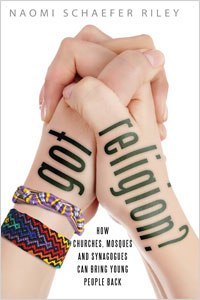 Defying the potentially tedious nature of analyzing the decline in religious participation among young people, Naomi Schaefer Riley’s new book, “Got Religion?: How Churches, Mosques, and Synagogues Can Bring Young People Back,” offers an engaging blend of statistical analysis and on-the-scene reporting about the rapidly shifting demographics of American religious involvement.
Defying the potentially tedious nature of analyzing the decline in religious participation among young people, Naomi Schaefer Riley’s new book, “Got Religion?: How Churches, Mosques, and Synagogues Can Bring Young People Back,” offers an engaging blend of statistical analysis and on-the-scene reporting about the rapidly shifting demographics of American religious involvement.
Riley spent time getting to know the leadership and participants in eight religious groups that are trying to succeed where so many others are failing. She provides an inside view into how these groups are addressing the decline in youth participation by exploring the ministries of Redeemer Presbyterian Church in New Orleans, MECA: Muslims Establishing Communities in America, the Alliance for Catholic Education (ACE), Birthright Israel, Mormon Young Single Adult (YSA) Wards, the First Baptist Church of Lincoln Gardens and Charlotte ONE.
All of these organizations are seeking to foster a sense of community, to bring young people together, to allow personal relationships to grow and to lay the groundwork for even greater things. This is the underlying theme of Riley’s book: how can religion create and sustain community when young people are increasingly abandoning these institutions as hopelessly boring, irrelevant and out-of-touch?
Unfortunately, Riley treads softly when it comes to divisive issues impacting the American religious landscape: marriage equality, abortion, women’s rights and homosexuality are all given short shrift. But surely the stances that most mainstream religious institutions take regarding these issues affects the desire of young people to be associated with them? Indeed, Charlotte ONE and MECA make conscious efforts to sidestep these issues. They know that explicit declarations of their positions on these issues will alienate the upcoming generation.
Depending on your perspective, the failure of religion to keep pace with the social values of the wider culture is either a recipe for failure or a mark of faithfulness. But underlying the relationship of the church and culture is a deeper question: is a decline in religious participation among young people even important?
Implicit in Riley’s study is the idea that religious community is a valuable, perhaps even essential, part of society. But what if it isn’t? Does society even need religion to function? Do we, as individuals, truly need to be part of a church or mosque or synagogue to live life to its fullest?
It’s great to get young people involved in small groups, to allow them to learn about and appreciate their cultural and religious heritages, to give them opportunities to serve and worship and pray and learn, but to what end?
Religion may need young people to survive, but do young people need religion?
Find out more about “Got Religion?” at the Patheos Book Club.
 Dan Wilkinson
Dan Wilkinson
Dan is the Executive Editor of the Unfundamentalist blog. He is a writer, graphic designer and IT specialist. He lives in Montana, is married and lives with two cats.
Leave a Reply